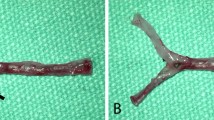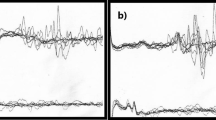Abstract
The hypoglossal nerve is used classically in salvage of facial paralyses in the absence of spontaneous recovery. A variety of ways of transferring and suturing the hypoglossal nerve to the distal segment of the facial nerve have been reported. In order to determine which mode of reconstruction is the best for neurotisation of the facial nerve, the caliber of the hypoglossal nerve was studied in ten subjects at the level of proximal and distal parts of the trunk and the cervical loop. The fascicular surface area of the cervical branch is inadequate for use. The distal extremity of the hypoglossal nerve has an ideal caliber to be sutured to the facial nerve trunk and the proximal part is large enough to allow partial harvesting of the hypoglossal nerve for neurotisation of the facial nerve.






Similar content being viewed by others
References
Asaoka K, Sawamura Y, Nagashima M, Fukushima T (1999) Surgical anatomy for direct hypoglossal-facial nerve side-to-end “anastomosis ”. J Neurosurg 91: 268–275
Caliot Ph, Dumont D, Bousquet V, Midy D (1986) A note on the anastomoses between the hypoglossal nerve and the cervical plexus. Surg Radiol Anat 8: 75–79
Conley J (1982) Hypoglossal-facial anastomosis. In: Brackmann DE (ed) Neurological surgery of the ear and skull base. Raven Press, New York, pp 93–98
Conley J., Baker DC (1979) Hypoglossal-facial nerve anastomosis for reinnervation of the paralyzed face. Plast Reconstr Surg 63: 63–72
Cusimano MD, Sekhar L (1994) Partial hypoglossal to facial nerve anastomosis for reinnervation of the paralysed face in patients with lower cranial nerve palsies: technical note. Neurosurgery 35: 532–533
Dongmo L, Laude M, Gouazé A, Laffont J, Ruchoux M, Ramos M (1988) Histométrie de l’anse de l’hypoglosse (ansa hypoglossi) chez l’homme. Etude quantitative des fibres myélinisées. Bull Assoc Anat 72: 46
Eppley BL, Snyders RV (1991) Microanatomic analysis of the trigeminal nerve and potential nerve graft donor sites. J Oral Maxillofac Surg 49: 612–618
Hammerschlag PE (1999) Facial reanimation with jump interpositional graft hypoglossal facial anastomosis and hypoglossal facial anastomosis: evolution in management of facial paralysis. Laryngoscope 109: 1–23
Hovelacque A (1927) Anatomie des nerfs crâniens et rachidiens et du système grand sympathique chez l’homme. Doin, Paris
Kessler LA, Moldaver J, Pool JL (1959) Hypoglossal-facial anastomosis for treatment of facial paralysis. Neurology 9: 118–125
MacKinnon, SE, Dellon AL (1995) Fascicular patterns of the hypoglossal nerve. J Reconstr Microsurg 11: 195–198
Manni JJ, Beurskens CHG, van de Velde C, Stokroos RJ (2001) Reanimation of the paralyzed face by indirect hypoglossal-facial nerve anastomosis. Am J Surg 182: 268–273
May M, Sobol SM, Mester SJ (1991) Hypoglosso-facial nerve interpositional jump graft for facial reanimation without tongue atrophy. Otolaryngol Head Neck Surg 104: 818–825
Pitty LF, Tator CH (1992) Hypoglossal-facial nerve anastomosis for facial nerve palsy following surgery for cerebellopontine angle tumors. J Neurosurg 77: 724–731
Rayatt SS, King TT, O’Connor F (1998) Histological analysis of the greater auricular nerve and its use as a graft. Clin Otolaryngol 23: 368–371
Sawamura Y, Abe H (1997) Hypoglossal-facial nerve side-to-end anastomosis for preservation of hypoglossal function: results of delayed treatment with a new technique. J Neurosurg 86: 203–206
Winckler G (1955) A propos des relations qui existent entre le plexus brachial et le nerf grand hypoglosse. C R Assoc Anat 92: 1415–1419
Yoleri L, Songür E, Yoleri Ö, Vural T, Cagdas A (2000) Reanimation of early facial paralysis with hypoglossal/facial end to side neurorrhaphy: a new approach. J Reconstr Microsurg 16: 347–356
Author information
Authors and Affiliations
Corresponding author
Rights and permissions
About this article
Cite this article
Vacher, C., Dauge, MC. Morphometric study of the cervical course of the hypoglossal nerve and its application to hypoglossal facial anastomosis. Surg Radiol Anat 26, 86–90 (2004). https://doi.org/10.1007/s00276-003-0197-8
Received:
Accepted:
Published:
Issue Date:
DOI: https://doi.org/10.1007/s00276-003-0197-8




